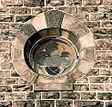Building Materials - Table of Contents.........,,,,,,,,,,,,,,,....... Illustrated Architecture Dictionary
Medina sandstone
| Medina Sandstone Society |
TEXT Beneath Illustrations
Click on photos for larger size
|
Medina sandstone sidewalk in front of the Williams-Pratt Mansion on Delaware Avenue |
Medina sandstone masonry and foliated capital ornamentation of Buffalo Psychiatric Center, designed by H.H. Richardson |
St. Louis RC Church on Main St. in downtown Buffalo |
|
One of Buffalo's best known landmarks: the 72-foot-tall St. Louis RC Church pierced spire, perhaps the only remaining pierced spire in the U.S. |
Quatrefoil tracery in a round window on a spire of the endangered Asbury Delaware Avenue Methodist Church |
Note the flying buttress of St. Paul's Episcopal Cathedral on Church Street |
|
The Connector: |
See also:
Wicks House
Atwater House (DEMOLISHED)
James B. Craven/Charles K. Bassett House
Sidewalk: 51 Symphony Circle
Sidewalk: Sears House







